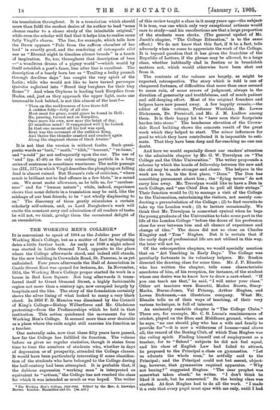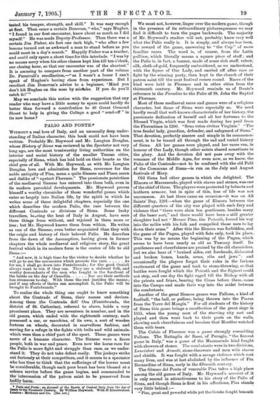IT is convenient to speak of 1904 as the Jubilee
year of the Working Men's College, but as a matter of fact its beginning dates a little further back. As early as 1848 a night school was started in Little Ormond Yard, opposite to the place where the College afterwards stood, and indeed still stands, for the new building in Crowndale Road, St. Pancras, is as yet unfinished. Four years afterwards the Hall of Association in Castle Street East was opened for lectures, &c. In November, 1854, the Working Men's College proper started its work in a house in Red Lion Square. Not long afterwards it trans- ferred itself to Great Ormond Street; a highly fashionable region not more than a century ago, now occupied largely by hospitals and the like. The story of the foundation certainly shows the silver lining of what looked to many a very black cloud. In 1858 F. D. Maurice was dismissed by the Council of King's College—Bishop Wilberforce and Mr. Gladstone protesting—from the Professorships which he held in that institution. This action quickened the movement for the Working Men's College. It seemed more than ever desirable as a place where the exile might still exercise his function as a teacher.
One naturally asks, now that these fifty years have passed, how far the College has fulfilled its function. The volume before us gives no regular statistics, though it states from Lime to time the numbers of students who, whether in days of depression or of prosperity, attended the College classes. It would have been particularly interesting if some classifica- tion of the students who have belonged to the College during the half-century had been attempted. It is probable that, if the dubious expression "working man" is interpreted as equivalent to "artisan," the College has not reached the class for which it was intended as much as was hoped. The writer
• no Working Men's Coitsge, 1854-1904. Edited by the Don. J. Llewelyu Davies. London: Macmillan and Co. [4s. net.]
of this review taught a class in it many years ago—the subject, it is true, was one which only very exceptional artisans would care to study—and his recollections are that a large proportion of the students were clerks. (The general upshot of Mr. Jacob's chapter, "The College Education," is to the same effect.) We do not know that this fact, if it be a fact, tells adversely when we come to appreciate the work of the College. It is beyond question that it has given the franchise of the Republic of Letters, if the phrase may be allowed, to a large class, whether habitually clad in fustian or in broadcloth matters not, which would otherwise have been shut out from it.
The contents of the volume are largely, as might be expected, retrospective. The story which is told is one of chequered fortunes, of difficulties that more than once seemed to mean ruin, of some errors of judgment, always in the direction of generosity and truthfulness, and of much patient and self-denying effort. Most of the original founders and helpers have now passed away. A few happily remain,—the editor of this volume, Professor Westlake, Mr. Lowes Dickenson, Dr. Furnivall, and Mr. J. M. Ludlow among them. It is their happy lot to "have seen their footprints harden into stone." The handsome elevation of the Crown- dale Road building shows the concrete result of the great work which they helped to start. The minor influences for good to which they have contributed it is impossible to esti- mate. That they have been deep and far-reaching no one can doubt.
And here we would especially direct our readers' attention to the admirable chapter by Mr. G. W. Trevelyan on "The College and the Older Universities." The writer propounds a scheme by which the bonds of fellowship between the new and the old may be made stronger and closer. The helpers in the work are to be, in the first place, "Dons." The Don has something permanent about him ; the "flying terms" do not carry him away. Mr. Trevelyan would like to have a Don in each College, and" one Chief Don to pull all their strings?' Their function would be (1) to manage a visit of the College to the Universities, entertaining the visitors, not merely con- ducting a perambulation of the College ; (2) to find recruits to take up the London work ; (3) to lecture occasionally. We think that Mr. Trevelyan is somewhat cynical when he begs the young graduate of the Universities to take some part in the life of the London College "before the doors of his profession close for ever between him and all chance of experience and change of idea." The doors did not so close on Charles Kingsley and " Tom " Hughes. But it is certain that if the early days of professional life are not utilised in this way, the later will not be.
Of the retrospective chapters, we would specially mention that on "Art Teaching in Early Days." The College was peculiarly fortunate in its voluntary helpers. Mr. Ruskin directed the drawing class for some time. Mr. J. P. Elmslie, who has written the chapter, tells some characteristic anecdotes of him, of his reception, for instance, of the student whose one desire was to know how to draw a cart-wheel. "If you can teach me that," he said, "I will enter your class." Other art teachers were Rossetti, Madox Brown, Stacy- Marks, Burne-Jones, Val Prinsep, Arthur Hughes, and Lowes Dickenson,—an illustrious company. What Mr. Elmslie tells us of their ways of teaching, of their very various technique, is full of interest.
An eminently readable chapter is "The College Clubs." There are, for example, Mr. C. B. Lucas's reminiscences of cricket, played on the Eton and Middlesex ground, where, as he says, "no one should play who has a wife and family to provide for "—it is now a wilderness of houses—and above all, the record of the Boxing Club, of which Tom Hughes was the ruling spirit. Finding himself out of employment as a teacher, for to " School " subjects he did not feel equal, and his class of English Law had failed to attract; he proposed to the Principal a class on gymnastics. "Let us educate the whole man," he artfully said to the Principal; and the Principal could not but assent, object- ing, however, that gymnastics required apparatus. "Why not boxing Fe" suggested Hughes. "The dear prophet was somewhat taken aback," he writes. "I don't think he liked it much, but he consented." So the boxing class was started. At first Hughes had to do all the work. "I made it a rule that every pupil must spar with me only, until I had
tested his 'temper, strength, and skilL" It was easy enough at first. Then came a certain Donovan, " who," says Hughes, "I found in our first encounter, knew about as much as I did myself." He was made Deputy-Professor. Then there was a certain Jim Fisher, six feet one inch high, "who after a few lessons turned out as awkward a man to stand before as you could meet in a day's march." Happily Fisher was a teacher, and could only spare a short time for this interlude. "I was by no means sorry when his other classes kept him till ten o'clock, our closing hour, so that our encounter was of the shortest." It is amusing to compare from another part of the volume Dr. Furnivali's recollection,—" as I wasn't a boxer I can't speak of Hughes's boxing class from experience. But I recollect Jim Donovan's advice to a beginner, Mind you don't hit Hughes on the nose by mistake. If you do you'll catch it!' "
May we conclude this notice with the suggestion that any reader who may have a little money to spare could hardly do better than forward a contribution to 46 Great Ormond Street to help in giving the College a good " send-off " in its new home P PALIO AND PONTE.*















































 Previous page
Previous page